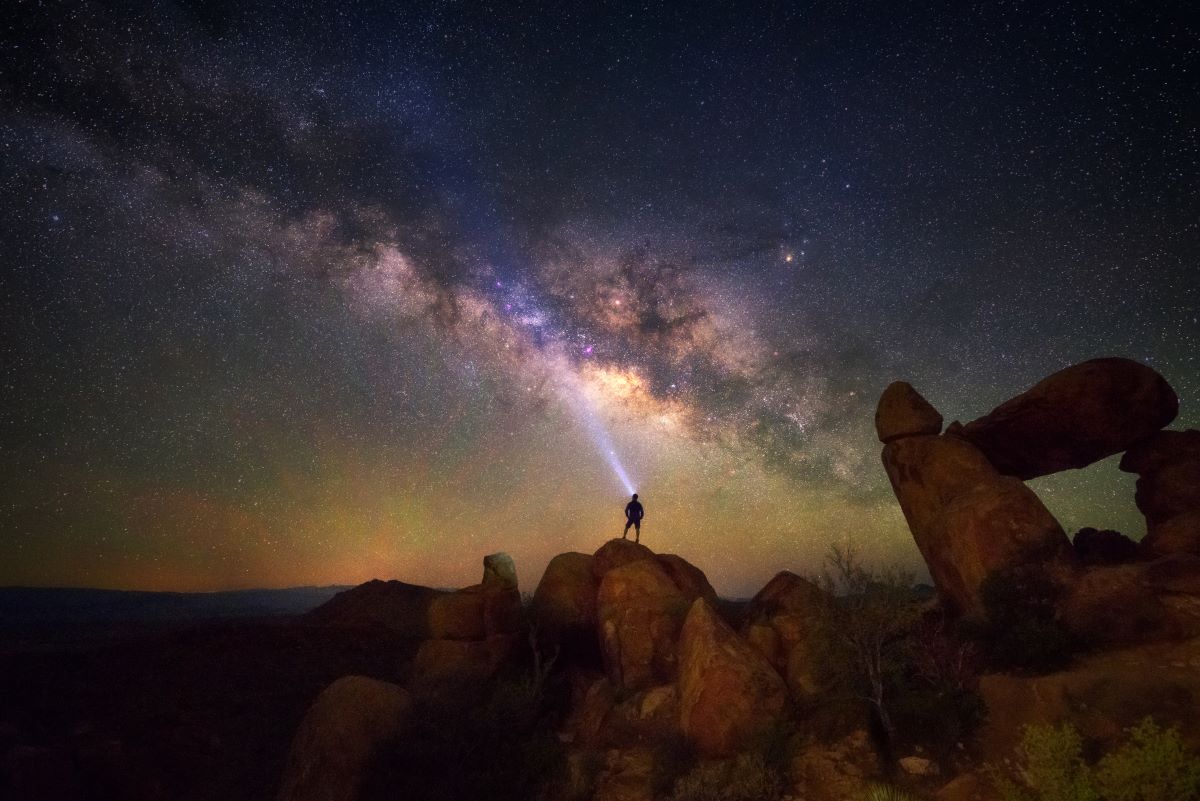The Best Places to Stargaze in America: International Dark Sky Week
In the hustle and bustle of modern life, the beauty of the night sky is often overshadowed—quite literally—by the pervasive glow of artificial lighting. Yet, once a year, there’s a global event dedicated to reclaiming the splendor of the cosmos: International Dark Sky Week (IDSW).
Scheduled for April 21-28, 2025, this annual week-long event coincides with Global Astronomy Month, and is strategically planned for the week of the new moon, ensuring the darkest skies for celestial observation.
This year, it culminates with the awe-inspiring Great North American Eclipse, offering an even more compelling reason to gaze upwards.
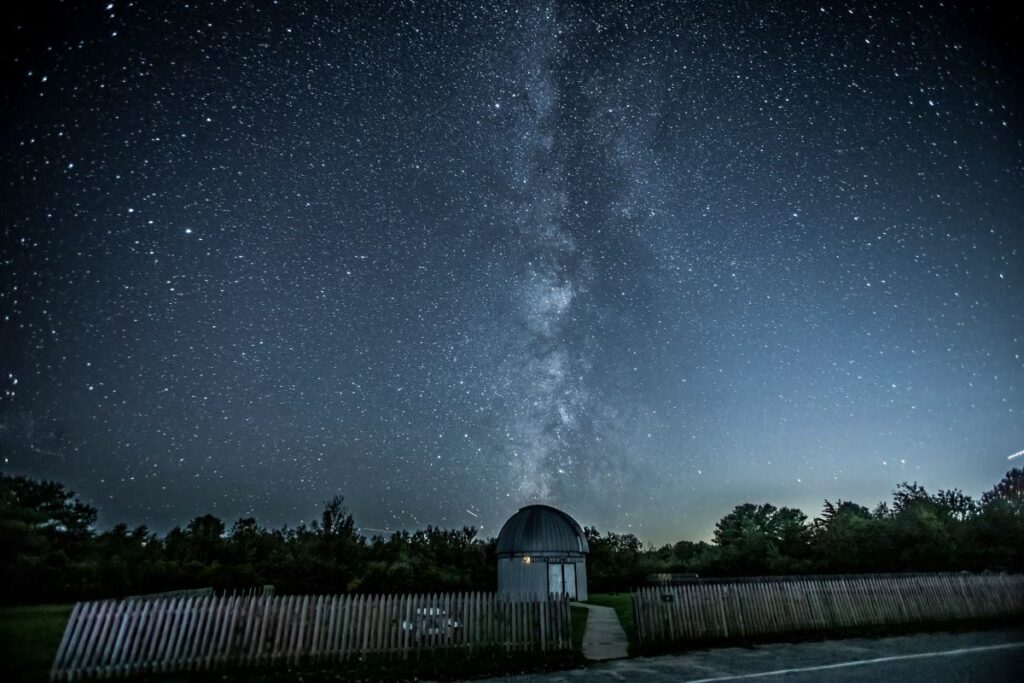
How Did International Dark Sky Week Start?
The inception of IDSW traces back to 2003, the brainchild of a visionary high school student, Jennifer Barlow. Motivated by a desire to preserve the night sky’s wonder from the encroaching effects of light pollution, Barlow’s initiative has grown into a worldwide movement under the aegis of DarkSky International.
“The universe is our view into our past and our vision into the future,” Barlow remarked, emphasizing the dual significance of the night sky as both a gateway to our cosmic heritage and a beacon of inspiration for future explorations.
A Week of Starry Delights
IDSW is more than just an occasion for astronomical enthusiasm; it’s a call to action for light pollution advocacy, a plea for the conservation of our night environment, and a celebration of the universe’s unspoiled beauty.
Here’s how you can partake in this celestial celebration:
- Step Outside: Gather your loved ones and venture into the night. Whether it’s a quiet evening in your backyard or a journey to a dark sky sanctuary, the simple act of observing the night sky can be profoundly moving.
- Spread Awareness: Use IDSW as a platform to educate others about the importance of dark skies. Resources provided by DarkSky International can help initiate conversations with your community, policymakers, and social circles.
- Engage in Citizen Science: Participate in Globe at Night, a project that allows you to contribute to global light pollution research. It’s an engaging way to make a difference while indulging your scientific curiosity.
- Learn and Advocate: Discover the broader implications of light pollution, from its negative impacts on human health and wildlife to concerns about energy waste and cultural heritage. Armed with knowledge, advocate for solutions that preserve our night skies.
- Join the Global Conversation: Share your IDSW experiences and connect with fellow dark sky enthusiasts through social media using the hashtag #IDSW during the annual event.
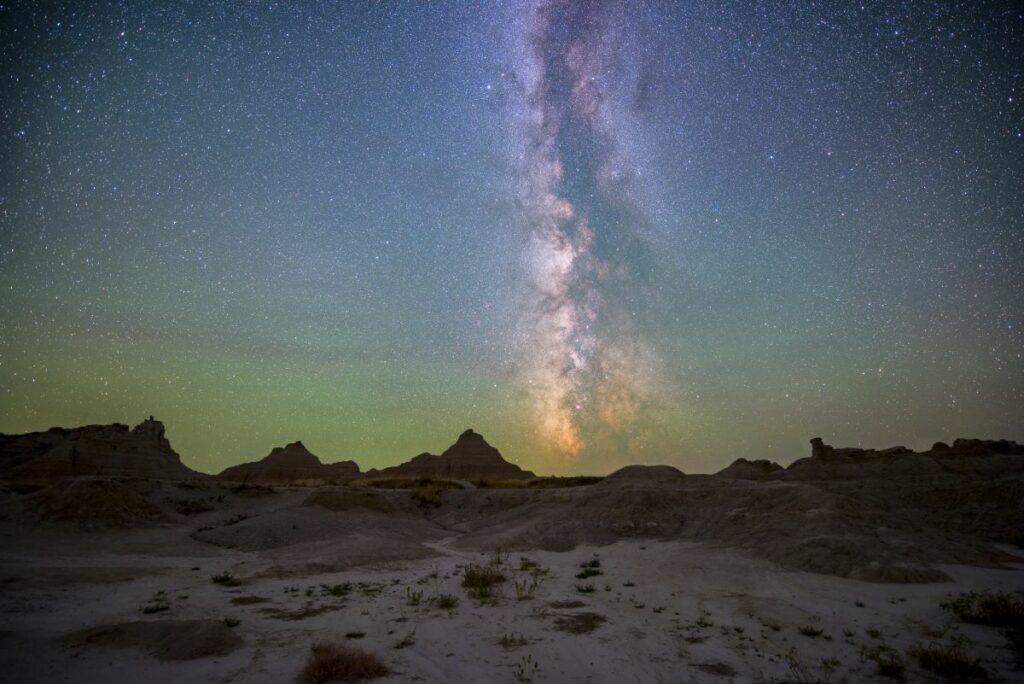
Where is the Best Place to Stargaze in the US?
Finding the best stargazing spot in each of the 50 states involves identifying locations with minimal light pollution, clear skies, and often, designated as Dark Sky Places by organizations like the International Dark Sky Association (IDA).
While it’s challenging to list the absolute best spot in each state due to the subjective nature of “best” and the changing status of Dark Sky Places, here’s a notable stargazing location in each state that is recognized for its dark skies and beautiful celestial views:
Alabama: Conecuh National Forest
Stargazing at Alabama’s Conecuh National Forest offers an escape into the serene beauty of the night sky, away from city lights. Here, the Milky Way stretches across the horizon, and constellations shine brightly, providing a perfect backdrop for reflection, education, and connection with the cosmos in a tranquil setting.
Alaska: Denali National Park and Preserve
In the vast wilderness of Denali National Park and Preserve, stargazers are treated to pristine skies. The aurora borealis often dances overhead, adding a magical display of color to the already breathtaking view of stars and planets in one of the most remote and wild places in America.
Arizona: Grand Canyon-Parashant National Monument
Stargazing at Grand Canyon-Parashant National Monument is an unparalleled experience. The monument’s isolation and minimal light pollution allow for a stunning display of the Milky Way, with countless stars illuminating the sky above one of the most geologically significant landscapes in the United States.
Arkansas: Buffalo National River
The Buffalo National River, with its dark, clear skies, offers a serene setting for stargazing. This untouched natural area provides a spectacular backdrop for viewing meteor showers, planets, and constellations, making it a cherished spot for astronomers and casual observers alike.
California: Death Valley National Park
Death Valley National Park, recognized as the hottest, driest, and lowest national park, also boasts some of the darkest night skies in the United States. Its vast, unobstructed horizons offer stargazers breathtaking views of celestial phenomena and the Milky Way’s sprawling arc.

Colorado: Great Sand Dunes National Park and Preserve
Great Sand Dunes National Park and Preserve offers a unique stargazing experience with its stark, sandy landscape contrasted against the dark, starry sky. The clear, high-altitude air and minimal light pollution create ideal conditions for viewing the Milky Way, planets, and meteor showers.
Connecticut: Van Vleck Observatory at Wesleyan University
At Wesleyan University’s Van Vleck Observatory, stargazers can delve into the wonders of the universe. The observatory provides educational programs and public viewing nights, making it a hub for those eager to learn about astronomy and observe celestial events through its powerful telescopes.
Delaware: Cape Henlopen State Park
Cape Henlopen State Park offers stargazers a peaceful beachside setting to observe the night sky. Its location away from the bright lights of nearby cities allows visitors to enjoy clearer views of the stars and planets, making it a favorite spot for night photography and celestial observation.
Florida: Kissimmee Prairie Preserve State Park
Kissimmee Prairie Preserve State Park is a haven for stargazers in Florida. Its designation as a Dark Sky Park ensures that visitors can enjoy some of the best starry nights in the state, with unobstructed views of the Milky Way, constellations, and other celestial wonders.
Georgia: Stephen C. Foster State Park
Nestled in the Okefenokee Swamp, Stephen C. Foster State Park is Georgia’s premier location for stargazing. Its remote setting minimizes light pollution, allowing for spectacular views of the night sky’s natural beauty, including the Milky Way, shooting stars, and distant galaxies.
Hawaii: Mauna Kea Summit
Atop Hawaii’s Mauna Kea, the world’s tallest sea mountain, the summit offers an unrivaled stargazing platform. Home to some of the most significant telescopes, this sacred site provides crystal-clear views of celestial bodies, making it a pinnacle for astronomical observation.
Idaho: Central Idaho Dark Sky Reserve
The Central Idaho Dark Sky Reserve, a sanctuary of natural darkness, sprawls across an expansive wilderness area. Here, the velvet night sky comes alive with a dazzling array of stars, offering a profound connection to the cosmos in one of America’s most pristine environments.
Illinois: Middle Fork River Forest Preserve
Nestled in the heart of Illinois, the Middle Fork River Forest Preserve is a tranquil retreat for stargazers. Its dark skies offer a splendid canvas for the Milky Way and meteor showers, providing a peaceful escape for those seeking to marvel at the universe’s wonders.
Indiana: Hoosier National Forest
Hoosier National Forest’s vast expanses of wilderness serve as a backdrop for spectacular nocturnal displays. The forest’s remote areas, free from artificial light, are ideal for observing the galaxy’s splendor, offering a serene setting for night sky enthusiasts.
Iowa: Whiterock Conservancy
Whiterock Conservancy in Iowa is a treasure trove for stargazers, with its rolling hills and dark skies. This conservation area provides a quiet haven for watching the stars twinkle and dance, offering visitors a chance to immerse themselves in the natural beauty of the night sky.
Kansas: Lake Scott State Park
Lake Scott State Park, nestled in the Kansas prairie, offers a serene lake setting for stargazing. The natural darkness of the surrounding area enhances the visibility of the night sky, allowing visitors to enjoy a peaceful evening under a blanket of stars.
Kentucky: Mammoth Cave National Park
Beyond its underground wonders, Mammoth Cave National Park boasts equally mesmerizing night skies. The park’s minimal light pollution creates an ideal setting for stargazing, where the Milky Way and numerous constellations can be observed in their full glory.
Louisiana: Kisatchie National Forest
Kisatchie National Forest’s vast, unspoiled wilderness provides a dark sky haven in Louisiana. The forest’s remote areas are perfect for laying back and gazing up at the stars, offering a tranquil escape for those looking to connect with the cosmos.
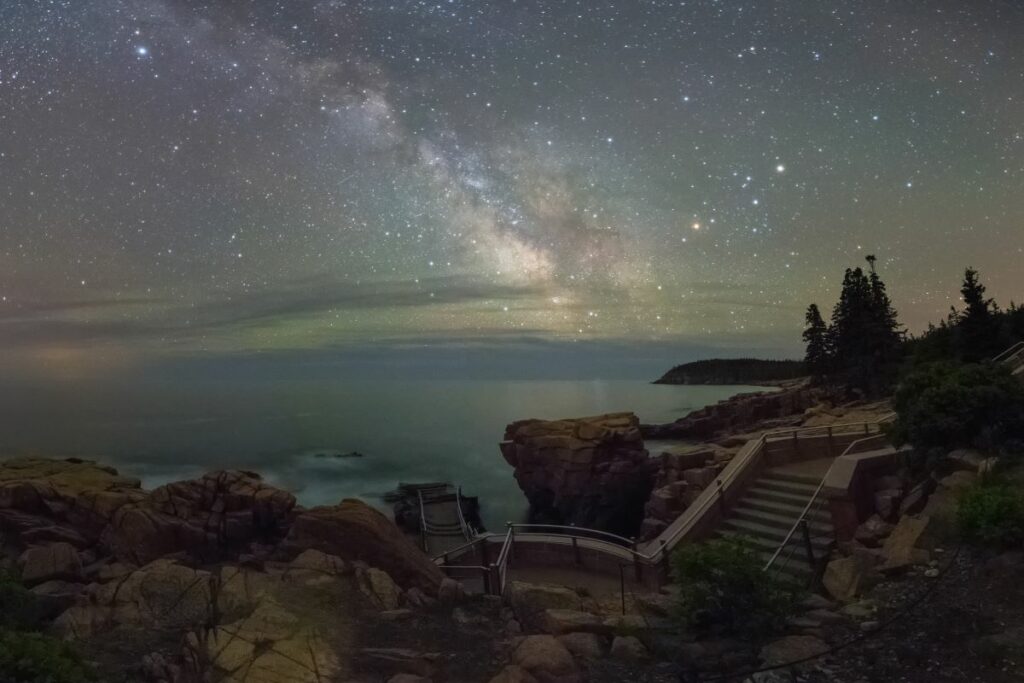
Maine: Acadia National Park
Acadia National Park on Mount Desert Island offers a unique coastal perspective for stargazing. Its rocky cliffs and clear, dark skies make it an exceptional location for viewing the stars and planets, especially during the park’s annual Night Sky Festival.
Related: Maine Eclipse 2024: Path Of Totality [ULTIMATE GUIDE]
Maryland: Assateague Island National Seashore
Assateague Island National Seashore, with its wild beaches and minimal light pollution, offers a stunning backdrop for night sky enthusiasts. The sound of the ocean waves complements the breathtaking view of the stars above, providing a magical stargazing experience.
Massachusetts: Mount Greylock
Mount Greylock, Massachusetts’ highest peak, offers stargazers a unique vantage point above the New England landscape. Its elevated position reduces light pollution, allowing for clearer views of the night sky’s celestial wonders, from shooting stars to distant galaxies.
Michigan: Headlands International Dark Sky Park
Nestled along the shores of Lake Michigan near Mackinaw City, Headlands International Dark Sky Park is a sanctuary for night sky admirers. Its protected status ensures dark skies that are perfect for witnessing the Milky Way, northern lights, and meteor showers in a serene, natural setting.
Related: 9 Michigan Dark Sky Parks & Preserves for Stargazing
Minnesota: Boundary Waters Canoe Area Wilderness
The Boundary Waters Canoe Area Wilderness, with its thousands of lakes and forests, offers an unparalleled off-the-grid stargazing experience. The absence of light pollution in this vast wilderness area allows for spectacular views of the stars reflected in the tranquil waters below.
Mississippi: Holmes County State Park
Holmes County State Park, with its quiet lakes and wooded areas, provides a peaceful backdrop for stargazing in Mississippi. The park’s natural darkness enhances the visibility of the night sky, making it a favored spot for observing the beauty of the cosmos.
Missouri: Mark Twain National Forest
Mark Twain National Forest’s expansive landscapes offer a secluded retreat for stargazers. The forest’s clearings and campgrounds are ideal for laying back and enjoying the night sky, where the stars and constellations shine brightly against the backdrop of Missouri’s natural beauty.
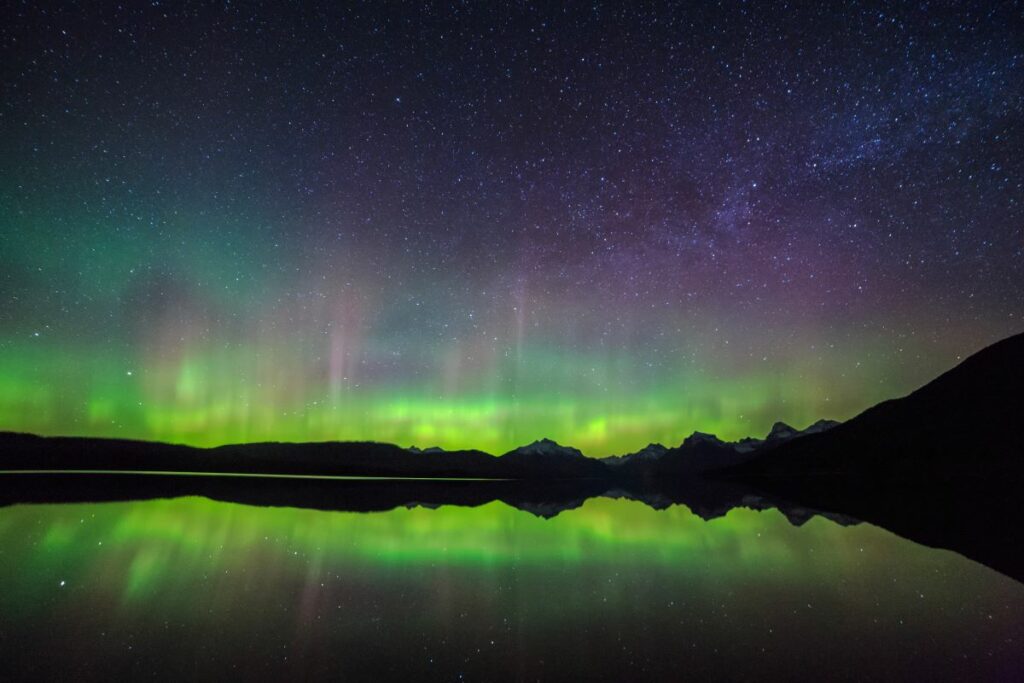
Montana: Glacier National Park
Glacier National Park’s rugged peaks and pristine lakes create a dramatic setting for night sky observation. The park’s remote location and clear air provide perfect conditions for viewing the Milky Way, making it a celestial spectacle for visitors.
Nebraska: Merritt Reservoir State Recreation Area
Merritt Reservoir State Recreation Area, with its dark skies and wide-open spaces, is a prime location for stargazing in Nebraska. The annual Nebraska Star Party here attracts astronomers for some of the best views of the night sky in the Great Plains.
Nevada: Great Basin National Park
Great Basin National Park offers some of the country’s most exceptional stargazing opportunities, thanks to its high elevation and isolated location. The park’s Lehman Caves add a daytime adventure, while its night skies are perfect for observing stars, planets, and galaxies.
New Hampshire: Mount Washington
The summit of Mount Washington, New England’s highest peak, provides breathtaking views above the clouds. Its unique weather conditions and clear skies offer a unique opportunity for stargazing, away from the light pollution of the cities below.
New Jersey: Jenny Jump State Forest
Jenny Jump State Forest is home to the United Astronomy Clubs of New Jersey, offering public observatory programs for a closer look at the cosmos. The forest’s elevation and clear skies make it an ideal spot for viewing celestial events and exploring the night sky.
New Mexico: Chaco Culture National Historical Park
Chaco Culture National Historical Park combines ancient history with stellar celestial displays. Its status as a Dark Sky Park highlights not only the cultural significance of the stars to the Chacoan people but also offers modern visitors spectacular views of the Milky Way and night sky phenomena.
New York: Adirondack Park
Adirondack Park’s vast wilderness areas provide a dark, clear canvas for stargazing. Its minimal light pollution and natural beauty make it a favorite for those looking to enjoy the night sky against the backdrop of mountains, lakes, and forests.
North Carolina: Blue Ridge Parkway
Near the southern reaches of the Smoky Mountains, the Blue Ridge Parkway offers numerous overlooks and quiet spots for stargazing along its scenic route. The high elevations and clear skies of the Appalachian Mountains provide breathtaking views of the stars and planets above.
North Dakota: Theodore Roosevelt National Park
Theodore Roosevelt National Park’s rugged landscape of the Badlands offers a unique nighttime spectacle. The park’s remote location ensures dark skies, making it an excellent place for viewing the Milky Way and night sky.
Ohio: John Glenn Astronomy Park
Named after the famed astronaut, John Glenn Astronomy Park in the Hocking Hills region is dedicated to sparking an interest in astronomy. With its open sky view and educational programs, it’s a prime spot for Ohioans and visitors to explore the wonders of the universe.
Related: ULTIMATE Guide to the 2024 Ohio Total Solar Eclipse
Oklahoma: Black Mesa State Park
Black Mesa State Park, located in the Oklahoma Panhandle, offers some of the darkest skies in the region. Its remote location is ideal for stargazing, providing clear views of the Milky Way and celestial events in the vast, open skies above the mesa.
Oregon: Crater Lake National Park
Crater Lake National Park, with its deep blue waters and surrounding cliffs, offers a stunning natural setting for night sky observation. The park’s high elevation and clean air contribute to incredibly clear views of starry nights, making it a memorable place for stargazing.
Pennsylvania: Cherry Springs State Park
Cherry Springs State Park is renowned for its exceptionally dark skies, making it one of the best stargazing spots in the eastern United States. Its designation as a Dark Sky Park ensures that visitors can enjoy spectacular views of the cosmos with minimal light pollution.
Rhode Island: Frosty Drew Observatory
Frosty Drew Observatory, located in Ninigret Park, is a hub for astronomy enthusiasts in Rhode Island. The observatory’s public stargazing nights offer a chance to observe the stars, planets, and other celestial objects through its telescopes, enhancing the stargazing experience.
South Carolina: Congaree National Park
Congaree National Park, known for its towering trees and biodiverse ecosystem, also offers unique stargazing opportunities. The park’s remote location away from city lights allows visitors to enjoy the beauty of the night sky in a natural, serene setting.
South Dakota: Badlands National Park
Badlands National Park’s rugged landscape provides a dramatic backdrop for stargazing. The park’s minimal light pollution allows for an unobstructed view of the night sky, making it a prime location for observing the Milky Way and celestial phenomena.
Tennessee: Pickett CCC Memorial State Park
Pickett CCC Memorial State Park, designated as a Dark Sky Park, offers some of the best stargazing in Tennessee. Its secluded location and commitment to preserving natural darkness ensure that visitors can enjoy breathtaking views of the stars and constellations.

Texas: Big Bend National Park
Big Bend National Park is one of the best places in the country for stargazing, thanks to its remote location and exceptionally dark skies. The park’s vast, open spaces provide panoramic views of the night sky, including the Milky Way and meteor showers.
Utah: Natural Bridges National Monument
Natural Bridges National Monument was the first National Park Service site to be designated as a Dark Sky Park. Its natural bridges form stunning silhouettes against the night sky, offering a unique setting for observing galaxies, nebulae, and stars.
Vermont: Quechee State Park
Quechee State Park, with its deep gorge and surrounding wilderness, offers a peaceful and picturesque setting for stargazing. The park’s natural beauty and dark skies make it a favorite spot for those looking to enjoy the night sky away from the city’s glow.
Virginia: James River State Park
James River State Park provides stargazers with wide-open skies along the scenic James River. Its location away from urban light pollution allows visitors to enjoy clear views of the stars, planets, and meteor showers in a tranquil, natural setting.
Washington: Olympic National Park
Olympic National Park offers diverse environments for stargazing, from mountain peaks to remote beaches. Its vast wilderness areas, far from city lights, provide pristine conditions for observing the Milky Way, meteor showers, and constellations in a stunning natural setting.
West Virginia: Spruce Knob
Spruce Knob, the highest peak in West Virginia, offers unparalleled views of the night sky. Its elevation and remote location minimize light pollution, creating ideal conditions for stargazing and making it a magnet for astronomers and night sky photographers.
Wisconsin: Newport State Park
Designated as a Dark Sky Park, Newport State Park on the Door Peninsula in Wisconsin provides exceptional stargazing opportunities along the shores of Lake Michigan. The park’s commitment to preserving natural darkness ensures that visitors can enjoy the beauty of the night sky in a serene, natural environment.
Wyoming: Grand Teton National Park
Grand Teton National Park’s iconic mountain landscapes offer a breathtaking backdrop for night sky observation. The clear skies and minimal light pollution in this remote area allow for spectacular views of stars, planets, and the Milky Way, enhancing the natural beauty of the park at night.
Note: These locations are recognized for their dark skies and offer various levels of accessibility and facilities. Some are designated International Dark Sky Parks, Reserves, or Sanctuaries, ensuring they offer some of the best stargazing experiences. However, the status and conditions of these places can change, so it’s a good idea to check the latest information and any visitor guidelines before planning your stargazing trip.
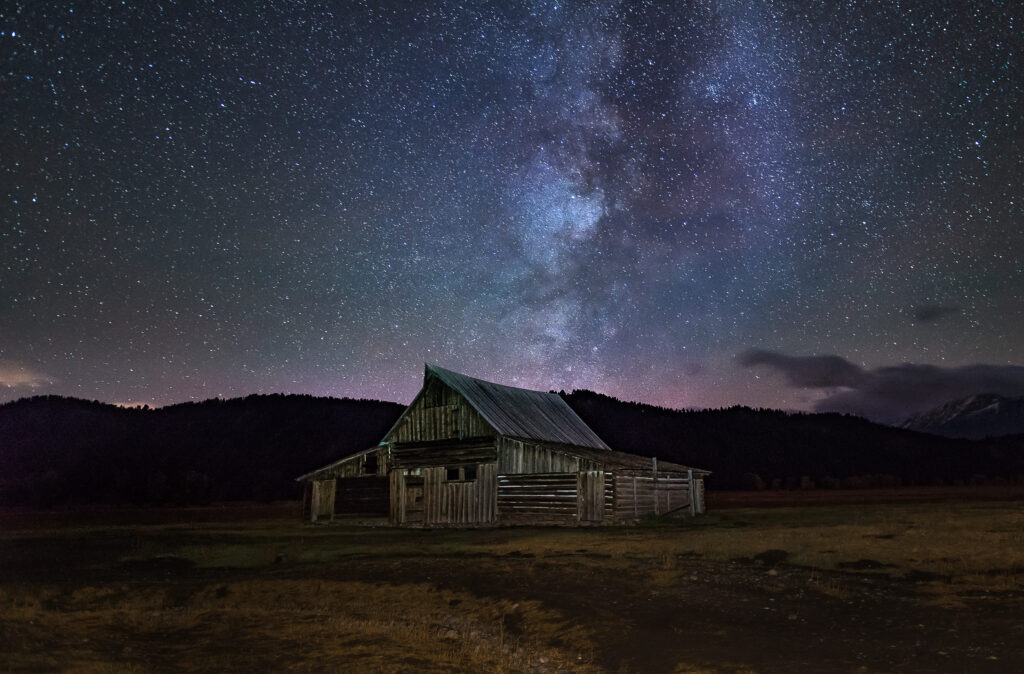
Celebrate the Night Skies Across America During International Dark Sky Week
The United States is home to a diverse array of stargazing havens, each offering a unique window to the cosmos. From the secluded wilderness of Alaska’s Denali National Park to the tranquil shores of Florida’s Kissimmee Prairie Preserve, these destinations offer more than just a view of the stars—they provide a profound connection to the natural world at its most awe-inspiring.
Whether you’re drawn to the ancient skies above New Mexico’s Chaco Culture National Historical Park or the iconic landscapes of Wyoming’s Grand Teton National Park, there’s a perfect spot in every state for celestial exploration. As we venture out to these dark sky sanctuaries, we’re reminded of the wonders that lie beyond our everyday view, inviting us to look up and ponder the vast mysteries of the universe.
These places gain even more significance during events like International Dark Sky Week, a time when the global community comes together to celebrate the beauty of the night sky and raise awareness about the importance of preserving our view of the stars.
So, as International Dark Sky Week approaches, let’s grab our telescopes, pack a blanket, and embark on a journey to discover the celestial wonders that await in America’s best stargazing destinations, joining a worldwide movement to cherish and protect our night skies.

